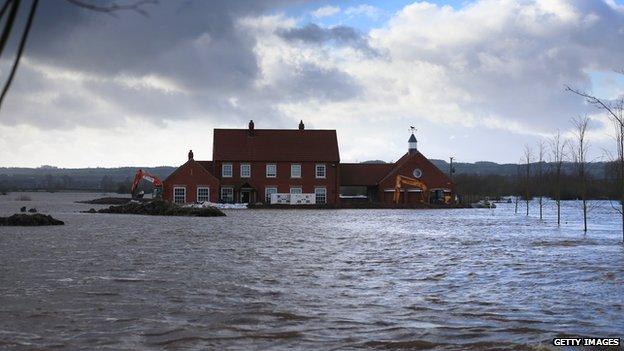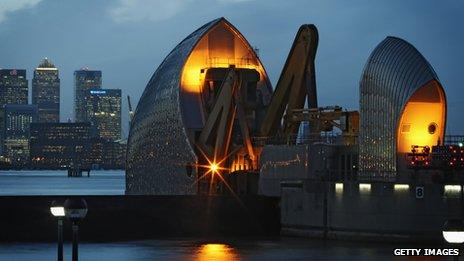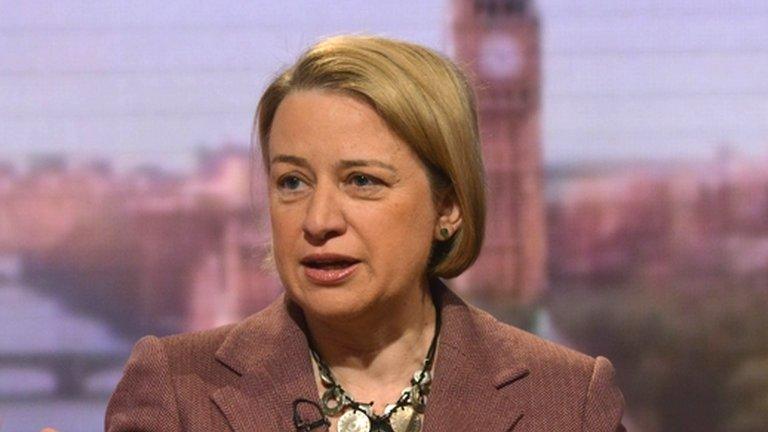Taking the war out of global warming
- Published
- comments

The widespread flooding in parts of England and Wales has encouraged debate about climate change
I once had a dream (or was it a dram?) in which the things we thought we knew for certain about the world were suddenly turned upside down.
In this strange universe, the cold war seemed to suddenly return, Ireland began to perform consistently at rugby, and arch-climate sceptics began to believe in dangerous levels of global warming.
Imagine my surprise then, on reading this new report, external from the Global Warming Policy Foundation (GWPF).
Here was one of the world's foremost bastions of contrariness when it comes to man-made climate change, admitting that temperatures were actually rising in response to human emissions of greenhouse gases.
And according to the study, the 2C threshold of dangerous warming would be crossed later on this century.
"On the highest emission scenario, our projection is 2.9C over pre-industrial," said Nic Lewis, one of the authors, pointing out that Intergovernmental Panel on Climate Change (IPCC) projects a considerably higher figure.
Huh? What about all that stuff we've heard in the past from those who refused to accept the science? That the whole thing was a warmist conspiracy, external, driven by out-of-work ex-communists?
Strangely, the GWPF are not highlighting this acknowledgement that man-made emissions are driving rapid changes in our climate, compared to the historical experience.
Sensitive questions
The report, written by independent researcher Lewis and Dutch science writer Marcel Crok, is focussed on the question of climate sensitivity - how will temperatures respond to a given increase in carbon dioxide in the atmosphere?
Lewis and Crok challenge two very critical numbers that are included in the recent IPCC report, external, known as AR5, that found that global warming was "unequivocal" and humans are the dominant cause.
These figures both relate to the temperature rises we are likely to see if levels of carbon dioxide in the atmosphere double.
The first is called the Transient Climate Response (TCR) and is said to be the temperature we'll see at the moment when CO2 crosses that line, expected to be sometime in the latter part of this century.
The second is called Equilibrium Climate Sensitivity (ECS) and this is the temperature we expect after the world has adjusted to the doubling of CO2, allowing for feedbacks such as the melting of polar ice and greater water vapour in the atmosphere.
Last September, the IPCC said that "the transient climate response is likely in the range of 1.0C to 2.5C (high confidence) and extremely unlikely greater than 3C".
Lewis and Crok disagree. The say that the models relied on by the IPCC do not give sufficient weight to real world recordings of temperatures. When they did the calculation they found a TCR of 1-2C with a best estimate of 1.35C.
When it comes to ECS, again Lewis and Crok reach a different conclusion than the collective wise beards of the IPCC, who gave a range of 1.5 to 4.5C with no best estimate for climate sensitivity.
The gentlemen from the GWPF suggest a range of 1.25-3.0 with a best estimate of 1.75C.
They base their argument for a lower range on the fact that previous research has overestimated the cooling impact of aerosols in the atmosphere.
Since observed temperatures have not increased over the past 17 years, while CO2 has, they say it changes all the calculations.
"It has to be the case," said Nic Lewis.
"The best forcing estimate in AR5 was 43% higher than in AR4, but temperatures have gone nowhere over the past 15 years and that necessarily implies that the climate is less sensitive than we thought."

Governments around the world need to have accurate predictions about climate change to ensure that they can adapt in time
"The (existing) models were built at a time when it was thought that this aerosol cooling was higher so the models needed to have a higher climate sensitivity or they would have been chucked out as not matching historical warming."
So how has mainstream science reacted to a research paper that has not been peer reviewed, written by people who are not employed at mainstream scientific institutions, casting doubt on a central tenet of their work?
While the contribution has not been embraced, it has had a welcome, albeit lukewarm.
"Their prediction of 1.35C is, even if correct, only 25% lower than the average of the general circulation models used in the IPCC AR5," said Prof Myles Allen from Oxford University.
"A 25% reduction in TCR means the warming we might have expected by 2050 might take until the early 2060s instead."
Other researchers argue that Lewis and Crok are cherry picking the data and that they are basing their conclusions on relatively few strands of evidence compared to the more broad-based IPCC report.
Lewis counters that something has gone seriously wrong with the statistics of the IPCC.
His analysis is all about the science, but he acknowledges that even his more optimistic conclusions will require changes to the way the world uses fossil fuels.
"I am not denying that it's a considerable policy challenge, I am not saying let's bury our heads in the sand, this is trying to present the science," he said.
Lewis also says that many of the mainstream scientists are "quite competent and sensible people".
It may not be a "peace in our time" moment but perhaps it might signal that the time is right for a new, more inclusive debate about climate change.
Dr Ed Hawkins, from the University of Reading, took encouragement from the fact that both the GWPF and the IPCC accepted that significant amounts of further warming were likely this century.
"If we broadly agree on this, the debate can crucially move on to what action is needed to deal with a warming planet," he said.
Some light perhaps, amid all the heat.
Follow Matt on Twitter, external.
- Published28 February 2014

- Published26 February 2014

- Published14 February 2014
